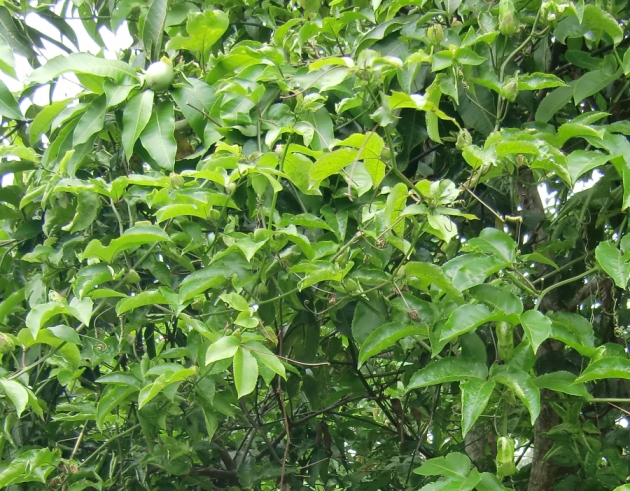

Passiflora edulis (Maracuja, Passion Fruit)
One species from the genus Passiflora and from the family Passifloraceae, originated to Brazil, Paraguay and Northern Argentina, today cultivated worldwide in the tropics and subtropics, has proven as the importantest species for cultivation. It is cold tolerant, but not hardy in Germany, but there are also hardy passiflora species for Germany which survive with winterprotection, the most known is Passiflora caercula. Passiflora edulis is grown also in altitudes of 3,333 to 7,666 feet (1,000 to 2,300 m) in South America.
Passiflora edulis is a woody climber, its shoots can grow to 33 feet (10 m) long. By tendrils it can grip at suitable pillars and trees. The darkgreen, glossy at the upper side, fine serrated leaves are alternate and triobate, at juvenile plants they are also single and are 2 to 10 inches (5 to 25 cm) long and wide.
The diameter of the flower amounts between 2.4 to 3.6 inches (6 to 9 cm), the flower has 5 stamens. The perianth is formed by 5 sepals (at the upper side white, at the underside greenish) and 5 white sepals. The four- to five-rowed, curly aureola (corona) is purpurish at the base, otherwise white.
The fruit is one berry. The peel is brownish-violet or yellow at egg-sized, round or oval fruits, the fruits are 3.2 to 4.8 inches (8 to 12 cm) long. Inside of them there are numerous seeds, each of them is surrounded by one juicy-jellylike, yellowish-orange arillus (is also called pulpa).
The edible fruits of Passiflora edulis are used for eating in-kind and for juice production and are also exported to Europe.

Passiflora edulis in our garden in December 2009.
Back to the Agricultural Plant List
Updated by Joachim Jaeck on April 2nd, 2010